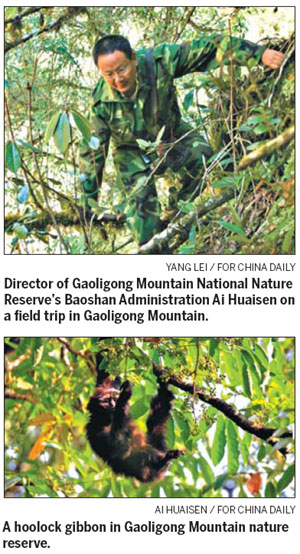Society
A mountain reserve shows the way to effective conservation
Updated: 2011-04-19 08:47
By Chen Liang and Li Yingqing (China Daily)
Talk to any nature reserve manager in China and you are likely to hear the same old complaints of poaching, logging and mining by local communities.
Ai Huaisen, director of Gaoligong Mountain National Nature Reserve's Baoshan Administration in Yunnan province, is an exception. Although there are 31 villages under his jurisdiction, he says that they pose no threat to his conservation efforts.
Ai and his colleagues helped establish the country's first farmers' association for biodiversity conservation in Baihualing village in Baoshan, in 1993.
 |
In 2005, they started an association for the protection of indigenous crafts, such as traditional paper making, in Xingzhuang village, Tengchong county; and in 2006, along with Nankang village in Tengchong, built a society for protecting hoolock gibbons.
The reserve has also supported 28 neighboring communities to establish similar organizations.
Besides promoting an awareness of the need for environmental protection, these grassroots organizations have helped improve local people's livelihoods, Ai says in his office in Baoshan. This has reduced the incidence of poaching and logging and conflicts between the reserve and surrounding villages are rare, he says.
His department has now shifted its focus to the targets of its conservation efforts, the area's fauna and flora, he says.
Stretching along the China-Myanmar border as the watersheds of the Nujiang (Salween) and Irrawaddy rivers, the Gaoligong Mountain reserve is known for its rich biodiversity, "unmatched by any of the country's nature reserves", according to the official.
Founded in 1986, its 405,500 hectares sit at an elevation of nearly 5,000 meters. Yunnan's largest nature reserve, it hosts 10 ecosystems and is home to nearly 5,000 native plant species, at least 150 types of mammals and more than 400 bird species.
"Of 24 primate species distributed in the country, eight can be found in our reserve," Ai says.
But he admits, "we actually know little about them".
"This is common among all reserve managers. We have spent too much time battling the people living near the reserves, and too little learning about the targets of our efforts."
Since 2004, his department has been putting more resources and facilities into surveying, monitoring and research. Dozens of books on the mountain range's fauna and flora have been published.
Ai and his colleagues say they now see encouraging signs of better conservation.
The habitat of the hoolock gibbon, one of the country's most endangered animals with an estimated population of about 200 distributed exclusively in the mountain range, has begun to expand in the reserve, says Ai, who is also a zoologist.
The red panda, usually difficult to spot below 2,800 meters, has been seen in areas as low as 1,900 meters above ground.
Meanwhile, the slow loris seems to be moving to higher ground, he says. "The small monkeys used to be seen only in areas below 1,000 meters," he says. "Now they can be seen at levels as high as 1,700 meters and have become common at 1,500 meters."
The impact of these changes, Ai says, needs to be further researched. "We are now ready for scientific conservation," he says.
E-paper

War of the roses
European Chinese rose growers are beating their Chinese rivals at their own game
High-tech park gets big boost
At the source
Merchant of Venice
Specials

Sino-US Dialogue
China and the US hold the third round of the Strategic and Economic Dialogue on May 9-10 in Washington.

Drunk driving
Drunk drivers face a detention for one to six months and a revokation of their drivers' license.

V-Day parade
A military parade marking the 66th anniversary of the Soviet victory over Nazi.
